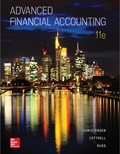
Concept explainers
a.
To prepare:
Introduction: Internal expansion refers to situation in a company forms a subsidiary by transferring some of its assets and liabilities and in exchange of ownership shares. Shares of the subsidiary is either provided to the shareholders in addition to their existing shares (Spin off) or in exchange of their existing shares (split off).
b.
To prepare: Journal entries that subsidiary company would record.
Introduction: Internal expansion refers to situation in a company forms a subsidiary by transferring some of its assets and liabilities and in exchange of ownership shares. Shares of the subsidiary is either provided to the shareholders in addition to their existing shares (Spin off) or in exchange of their existing shares (split off).
Want to see the full answer?
Check out a sample textbook solution
Chapter 1 Solutions
EBK ADVANCED FINANCIAL ACCOUNTING
- subject general accounting questionarrow_forwardhelp me to solve this accounting questionarrow_forwardGrunewald Industries sells on terms of 3/10, net 40. Gross sales last year were $4,161,000 and accounts receivable averaged $370,500. Half of Grunewald's customers paid on the 10th day and took discounts. What are the nominal and effective costs of trade credit to Grunewald's non-discount customers? (Hint:Calculate daily sales based on a 365-day year, calculate the average receivables for discount customers, and then find the DSO for the non-discount customers.) Do not round intermediate calculations. Round your answers to two decimal places. Effective cost of trade credit =arrow_forward
- What was cost of goods manufactured for the period?arrow_forwardDuring September, 8,500 units were produced. The standard quantity of material allowed per unit was 9 pounds at a standard cost of $5.50 per pound. If there was an unfavorable usage variance of $18,975 for September, what amount must be the actual quantity of materials used?arrow_forwardGeneral accounting questionarrow_forward
